There are over twenty species of snakes in Wisconsin, but only two species of venomous snakes, which both happen to be rattlesnakes, reside in these areas.
If you are a snake-lover living in Wisconsin, this is the article for you. While you can find many different species of snakes in Wisconsin, some are common, while others are underway of becoming an endangered or almost endangered species.
The reason for their endangerment or threatened status is mostly due to habitat loss, whether through pollution, over-harvesting, or climate change, as well as disease. These are all major reasons for the decrease in the snake population.
If you are interested in keeping a snake as a pet, it is stated under the Oneida Nation of Wisconsin (Native American Community) that “any poisonous or venomous amphibian, arachnid, or reptile including snakes, any snake not indigenous to Wisconsin, any indigenous snake exceeding 5 feet (bullsnakes, western fox snakes, and midland/black/gray ratsnakes) prohibited.”
In Wisconsin, it is illegal to keep any species that are native to the area, especially those not subject to any hunting regulations. You may not sell fo trade these reptiles without a license, except for some species that can be used for bait when fishing.
A license is required in order to import, breed, hunt, or purchase wild animals according to Wisconsin wildlife laws. Violation of these laws may result in fines or even imprisonment.
Table of Contents
Common Snake Species of Wisconsin
Here are some of the common snakes you can find in Wisconsin:
1. Common Watersnake
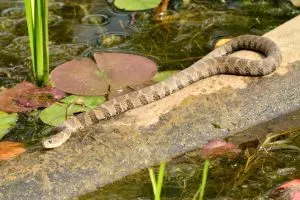
- Experience Level: Intermediate
- Family: Colubridae
- Scientific Name: Nerodia sipedon
- Other Names: Watersnake, Water snake, Common Water snake
- Adult Size: 24 to 55 inches
- Lifespan: About 10 years in captivity (wild lifespan unknown)
- Average Price Range: around $20 per snake
Water snakes are popular pet choices due to their small size, docile behavior, and infrequent feeding schedule. They do not require much effort to keep, are non-venomous, and are usually relatively safe to keep.
We recommend you buy from a buyer that sells them captive-bred since that means that they are already tamed and socialized. This means they may already be accustomed to being handled, making it easier for keepers.
These snakes usually come in darker shades of brown, gray, or tan. On their backs, you may find a bunch of blotches that might alternate and form bands throughout their length. These markings may fade with age.
Common Watersnakes have keeled scales on their undersides that look like white and red half-moons with a divided anal plate and gray speckles.
Their body size can range anywhere from medium to a larger, heftier girth.
These snakes are called Watersnakes because they enjoy residing in places near bodies of water. They prefer clean rivers but can also be found in almost any type of aquatic environments like ponds, streams, and swamps.
They can be found in any warm, shallow water that has easy access to basking spots on logs, piers, and rocky ridges.
Common Watersnakes enjoy feeding on slow-moving fish, various amphibians, and crayfish.
While these guys are non-venomous, some people will mistake them for the venomous Water Moccasin or Cottonmouth because they are similar in appearance. This misunderstanding causes these species to be wrongfully killed more often than they should be.
However, Cottonmouths do not reside or roam in areas anywhere near Wisconsin.
2. Common Garter Snake
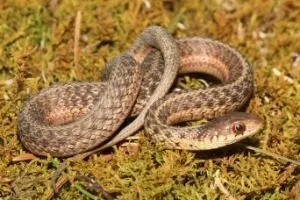
- Experience Level: Beginner
- Family: Colubridae
- Scientific Name: Thamnophis sirtalis
- Other Names: Gartersnake, Common Gartersnake
- Adult Size: between 23 and 32 inches
- Lifespan: 2 years (in the wild); 10 years (in captivity)
- Average Price Range: $20 to $300 per snake
While Garter snakes are quite friendly when it comes to handling and seem to make really great pets. These guys are protected by Wisconsin as a threatened species.
There is an abundance of this species available in the wilderness of Wisconsin, however, taking them from their natural habitat is illegal.
Captive-bred Garter Snakes are docile, friendly, non-venomous, and curious beings that will explore your hands and wrists. They are not constrictors, which is what makes them easy to handle and fun to keep as pets.
They also do not have any fangs for biting. However, they can bite and have a few rows of tiny teeth. If you happen to get nipped, it should be cleaned properly or it might get infected. In rare cases, some people are even allergic to their saliva, so keep that in mind.
They can make homes out of most habitats but prefer to live in meadows, woodlands, forests, hillsides, marshes, and open canopy or freshwater wetlands. They can most often be found near aquatic habitats, where they can flee when predators are nearby; they are very excellent swimmers.
Common Garter Snakes can be identified by their three lightly-colored stripes that run along the length of their black, brown, olive, or gray bodies. These stripes may vary in color depending on the snake, but they will typically be yellow, blue, white, green, or brown.
They are considered low-level predators, meaning that they feed on smaller animals like earthworms, newts, toads, and such, while these snakes are prey to predators that sit higher on the food web.
Wisconsin is home to 5 different species of gartersnakes including common gartersnakes, eastern and western ribbonsnakes, plains gartersnakes, and the Butler’s gartersnake.
3. DeKay’s Brownsnake
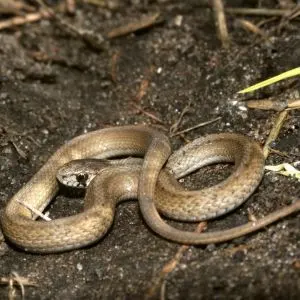
- Experience Level: Beginner
- Family: Colubridae
- Scientific Name: Storeria dekayi
- Other Names: Brown Snake, DeKay’s Brown Snake
- Adult Size: approximately 13 inches
- Lifespan: 7 years in captivity; unknown in the wild
- Average Price Range: $20 to $30 per snake
Brownsnakes are not shy and humans commonly encounter them. They can make great pets for beginners due to their size and gentle nature. They are also quite easy to feed.
These non-venomous snakes are usually brown in color, as their name suggests, but can also come in a yellowish, red, or grayish-brown tone.
They will typically have two rows of either darker or lighter spots which might also be linked, making it look like a collar or middorsal streak down the side of their head. Underneath each of their eyes may also be a small, dark spot.
These markings may also not appear on some individuals.
Their undersides will either be white or tan.
They like to reside in various woodlands, more commonly in wet areas like swamp edges or wetland borders. They like to roam the litters of abandoned fields, lowland hardwoods, prairies, and oak savannas.
They are also often spotted in residential areas or urbanized territories.
In their habitats, they will consume small invertebrates like earthworms, slugs, and snails with their specialized jaws and teeth. They may also eat beetles and salamanders if they come across one.
4. Eastern Hognose Snake
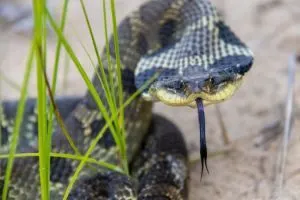
- Experience Level: Beginner
- Family: Colubridae
- Scientific Name: Heterodon platirhinos
- Other Names: Eastern hog-nosed snake, Spreading Adder
- Adult Size: 20 to 33 inches
- Lifespan: 12 years
- Average Price Range: $100 to $500 per snake
The Hognose snake is known to be one of the best pet snakes for enthusiasts since they are not fussy and are comfortable with human interaction. They also stay relatively small and are only slightly venomous while still being safe to keep around humans.
These worm-like snakes have a large, round head with an upward-facing snout, which is what we all love about them. They are dark gray or olive-green, but some are also yellow, tan, or light brown with dark brown spotted or black patterns on their head and sometimes their bodies.
They prefer to inhabit sandy woodlands, farmland, coastal areas, and fields where they feed on frogs, salamanders, invertebrates, birds, and small mammals. They can use their hog-like nose to get into their prey’s burrows more easily.
5. Milksnake
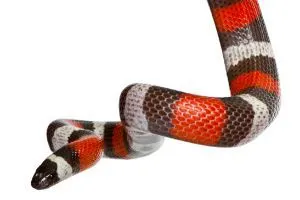
- Experience Level: Beginner
- Family: Colubridae
- Scientific Name: Lampropeltis triangulum
- Other Names: Milk Snake
- Adult Size: 24 to 36 inches
- Lifespan: up to 20 years in captivity; 15 years in the wild
- Average Price Range: $50 to $300 per critter (depending on species, size, gender)
Milksnakes are a non-venomous, docile, beautiful snake that is great for beginners. They are a species of kingsnake that will vary significantly in color, patterns, and size, depending on the individual snake.
They are generally colorful with a gray or tan body with a V or Y-shaped pattern on their neck. They are usually striped or blotched with black and copper, rusty, red or orange with white, or yellow blotchy striped patterns amongst these colors as well.
Again, these can be significantly different depending on the subspecies, but typically, they will look like they are black, white, and red-orange striped. All milksnakes will have black and light stripes or blotches throughout their length.
While Milksnakes can make a home out of a variety of habitats, they prefer forest edges, prairies, open woodlands, rocky hillsides, near rivers or streams, grasslands, rocky hillsides, rocky mountains, and suburban farmlands.
They do not like to be seen and have a secretive demeanor.
They are carnivorous snakes, feeding on rodents, birds, small reptiles, and their eggs. They may also eat other snakes, even as hatchlings.
Check out this video for more information on how to care for this awesome, beautiful pet snake:
6. Northern Ringneck Snake
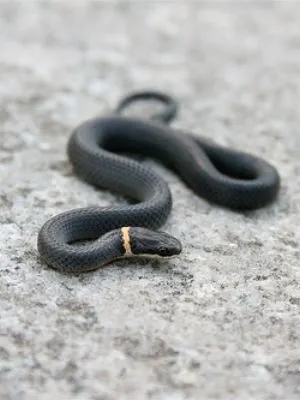
- Experience Level: Intermediate
- Family: Colubridae
- Scientific Name: Diadophis punctatus edwardsii
- Other Names: Northern Ring-necked Snake
- Adult Size: 10 to 15 inches
- Lifespan: 10 to 20 years in the wild; 6 years in captivity
- Average Price Range: $20 to $50 per snake
While you can keep these small snakes as pets, they do not usually do too well in captivity due to their timid nature and difficulties when breeding. All subspecies of the Ringneck snakes are threatened in their native habitats and should not be captured.
Ringneck Snakes are not the easiest to take care of since they have specific needs in order to stay alive. They also don’t make the best pets since they want to remain hidden at all times.
A lot of Ringnecks will be captured and taken from their habitats into the hands of overzealous first-time keepers. Usually, they will refuse to eat after a week or two in captivity.
If you are interested in trying to keep a Ringneck, please watch this video for more details:
However, they respond to handling quite well since they are not aggressive. Even though they are slightly venomous, their poison is comparable to that of a bee’s sting.
Ringnecks’ well-known defense mechanism is the curling up of their tail, which shows off their bright red underside and happens when they are feeling threatened. While they are non-aggressive, they may try to nip at you, but even that will be hard to do since they have rear-facing fangs.
They pose very little threat to humans who want to handle them but do not enjoy being seen and like to remain hidden.
Northern Ringneck Snakes have a flat, black head with smooth scales all throughout their thin body, which is usually dark gray or a dull blue-gray in color. Their undersides may be a bright or pale yellow sometimes with small speckles or spots.
They get their name from the yellow or orange band that circles their neck. There are many subspecies that might vary in color.
They are sometimes mistaken to be Prarie Ringnecks since they are similar in size as well as color. You can differentiate them by looking at their undersides since a Northern Ringsnake will have a solid pale yellow belly without any markings.
These tiny snakes don’t like to be seen or out in the open so they like to inhabit areas like moist forests or dry deciduous forests. In these habitats, you can find them feasting on earthworms, smaller snakes, salamanders, small amphibians, and beetles.
7. Red-bellied Snake
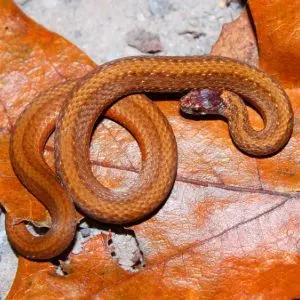
- Experience Level: Intermediate
- Family: Colubridae
- Scientific Name: Storeria occipitomaculata
- Other Names: Redbelly snake, Redbellied Snake
- Adult Size: 8 to 16 inches
- Lifespan: 4 years in captivity; Wild lifespan unknown but predicted to be longer than in captivity
These small snakes are extremely common in Wisconsin and can be found in swarms basking in the sun on the warm days of September to October. You can also find them in Wisconsin woodlands, fields, under logs, in forests, bike trails, back roads, and sphagnum bogs.
In these areas, they feed on earthworms, beetle larvae, and slugs.
People can sometimes find them out in their pesticide-free garden or just out in the wild and might want to keep them as a pet. However, they really struggle to eat when in captivity and will sometimes just outright refuse when they are removed from the wild.
They do not do well in captivity and prefer to be free to roam the lands as they please. Although they aren’t hard to obtain in Wisconsin, they might not be the best pet to keep if you are planning to have it for long since they do not do well away from their natural habitat.
It’s not hard to identify these snakes since they really do live up to their name with their flashy red or orange undersides. Their bodies might be a dark steel grey, black with a blue tint, or copper brown. Some may also have two dark stripes along their sides or a thick, light-colored band down the middle of their backs.
While they will usually first curl their tails or flee in defense before they try to bite, their little nibble probably won’t affect you anyway.
While they are small and beautiful, this does not mean they will make a good pet since they do not usually survive long in captivity.
8. Smooth Green Snake
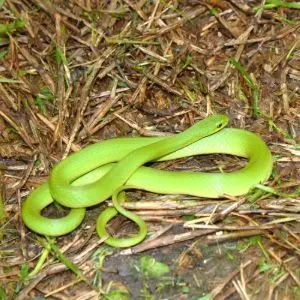
- Experience Level: Intermediate
- Family: Colubridae
- Scientific Name: Opheodrys vernalis
- Other Names: Green Snake
- Adult Size: 14 to 20 inches
- Lifespan: 6 years
- Average Price Range: $8 to $10 per snake
Smooth Green snakes are carnivorous but prefer to feed on insects, making them somewhat insectivorous. This is the perfect reptile for owners that might be squeamish about feeding dead mice to their snakes.
These guys will mostly eat insects like spiders, moths, ants, snails, slugs, worms, and spineless caterpillars.
One drawback that does not make them great pets, though, is that they are way too timid for human interaction and are easily stressed. However, they are known to be docile and some might even enjoy being handled.
Just like their name suggests, these snakes have bright green scales, which can range in shade. They stay relatively small and may have a pale yellow underside with little, beady, black eyes.
They thrive in moist, grassy areas and can be found in open woods, stream edges, marshes, and meadows.
Endangered Snake Species of Wisconsin
The following is a list of endangered snake species that reside in Wisconsin:
9. Eastern Foxsnake
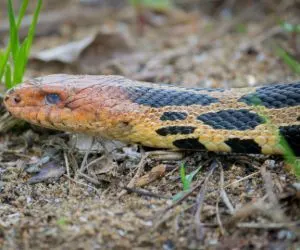
- Experience Level: Intermediate
- Family: Colubridae
- Scientific Name: Pantherophis gloydi
- Other Names: Eastern Fox Snake, Pine Snake
- Adult Size: 3 to 5.5 feet
- Lifespan: 17 years in captivity; wild lifespan unknown
- Average Price Range: $60 to $200 per snake
Eastern Foxsnakes are not usually kept as pets since their population is so sparse and they are now endangered. Although many people will still have them as pets due to their docile nature.
These snakes are known to give off a foul, dank, musky odor through their tails.
They can be identified by their shiny, rust-like colored head and gold or light brown or tan body. Along their body, they have dark-colored, usually brown, blotches.
Their undersides are pale yellow and black. They have a short, flat nose and deep-set, round, yellow, or golden eyes, which gives them a fox-like look, hence their name.
They like herbal gardens, vegetated dunes, beaches, open woodlands or fields, and any open wetland environment. While they are considered terrestrial snakes, that does not mean that they aren’t great swimmers or climbers.
They typically feed on baby birds, other animal eggs, and amphibians, constricting and suffocating them with the tight coil of their bodies.
10. Massasauga Rattlesnake
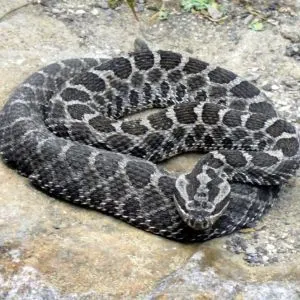
- Experience Level: Expert
- Family: Viperidae
- Scientific Name: Sistrurus catenatus
- Other Names: Eastern Massasauga, Massasauga Rattlesnake
- Adult Size: about 2 feet
- Lifespan: 14 years
The Eastern Massasauga is protected by The U.S. Fish and Wildlife Service under the Endangered Species Act. This means that they cannot be taken from the wild and are not to be messed with.
A bite from one of these vipers will not be one you will forget and could also kill you. Although, they are quite shy creatures which is why bites don’t happen too often and are considered a rare occurrence.
The majority of their population can be found in Wisconsin as well as Ontario, and only an average of one or two bites are reported per year in these areas.
Massasaugas are tan or gray in color with bright brown blotches along their back and smaller blotchy patterns along their sides.
In the wilderness, they choose to live in open, rocky areas since these environments will allow them to bask freely with multiple options. They may also be found in deserts, forests, prairies, and marshes.
They like areas where they can take cover from bird predators and where prey is abundant. They will eat insects, lizards, smaller snakes, and amphibians but they mainly feed on smaller mammals.
When hunting, these vipers are the stalking type, sitting and waiting for their prey. They have special pits near each of their eyes that are heat-sensitive and will alert them when prey is near.
They will then inject them with a little bit of their toxic venom before swallowing them whole.
11. Eastern Ribbonsnake
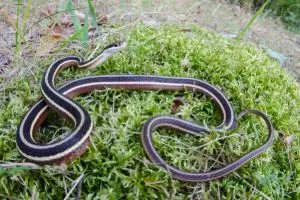
- Experience Level: Beginner
- Family: Colubridae
- Scientific Name: Thamnophis sauritus
- Other Names: Ribbon Snake
- Adult Size: 16 to 35 inches
- Lifespan: 10+ years in captivity; wild lifespan unknown
- Average Price Range: $20 to $50 per snake
Ribbonsnakes are the most common species of Garter Snakes there are. These shy, non venomous snakes make popular pets due to their many morph options and the fact that they are not dangerous to keep.
Eastern Ribbonsnakes are the best tempered out of all the subspecies of Ribbonsnakes and can make good pets for novice snake keepers when bought from a reputable pet store where they are captive-bred, of course.
However, it is important to note that both Western and Eastern Ribbonsnakes are illegal to own in Wisconsin since they are under the protection of the Department of Natural Resource’s Bureau of Natural Heritage Conservation as an endangered species. If you do wish to own one, you will have to get an Endangered and Threatened Species Permit from this department.
Ribbonsnakes are usually tan or dark brown with prominent light-colored stripes throughout their length which is usually a bright or pale yellow.
Eastern Ribbonsnakes are semi-aquatic creatures and can be found mostly near a water source like the shorelines of rivers or lakes. They will sometimes inhabit water edges near forests or wetlands.
They are carnivorous and feed on small fish, insects, and tadpoles.
12. Western Ribbonsnake
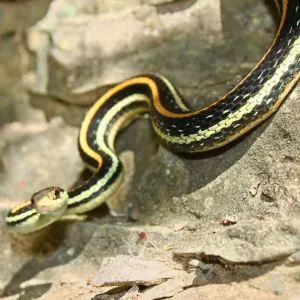
- Experience Level: Beginner
- Family: Colubridae
- Scientific Name: Thamnophis proximus
- Other Names: Ribbon Snake
- Adult Size: around 3 feet
- Lifespan: 10+ years in captivity; wild lifespan unknown
- Average Price Range: $20 to $50 per snake
Another Ribbonsnake, which the most common species of Garter Snakes, is the Western Ribbonsnake. As we mentioned with the Eastern, they have various morphs to pick from and are a non venomous snake, making them an attractive pet choice.
However, again, both Western and Eastern Ribbonsnakes are illegal to own in Wisconsin since they are under the protection of the Department of Natural Resource’s Bureau of Natural Heritage Conservation as an endangered species. If you do wish to own one, you will still have to get an Endangered and Threatened Species Permit from this department.
Similar to the Eastern, Western Ribbonsnakes can be brown, almost black, or olive-colored with their signature pale yellow or light green stripes along their bodies.
Ribbonsnakes are semi-aquatic and can be found near a water source like the shorelines of rivers or lakes. They will sometimes inhabit water edges near forests or wetlands.
They are carnivorous and mainly feed on small fish, insects, and tadpoles.
13. Queensnake
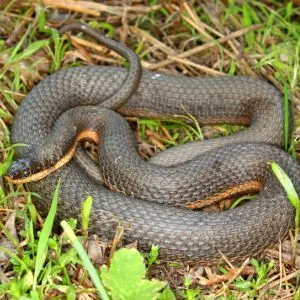
- Experience Level: Beginner
- Family: Colubridae
- Scientific Name: Regina septemvittata
- Other Names: Queen Snake
- Adult Size: up to 24 inches
- Lifespan: over 19 years in captivity; wild lifespan unknown
- Average Price Range: around $30 per snake
While these snakes are friendly, docile, and take well to handling, they are listed as an endangered species and protected under the Endangered Species Act by the U.S. Fish and Wildlife Service.
The Queensnake is similar in appearance to the Garter Snake, which causes much confusion when identifying them. They are slender with dark olive or brown bodies with cream or pale yellow stripes along each side of their bodies.
They can be spotted in mountainous regions and sometimes along river drainages. They like to make homes near streams where they hide under rocks and find opportunities to bask in the sun when they can.
They mainly feed on soft, just-molted crayfish without hard exoskeletons.
Snake Species of Special Concern in Wisconsin
Here are some snakes that are listed as Threatened Endangerment in Wisconsin:
14. Butler’s Gartersnake
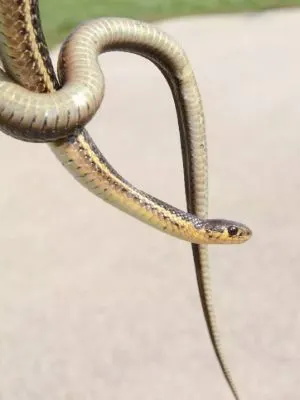
- Experience Level: Beginner
- Family: Colubridae
- Scientific Name: Thamnophis butleri
- Other Names: Butler’s Garter Snake
- Adult Size: 15 to 20 inches
- Lifespan: 14 years in captivity; wild lifespan unknown
This species of Garter Snake has a stout, dark brown, dark olive, or almost black body with three distinctive lateral orange, yellow, or cream stripes along their body.
Subspecies of Garter Snakes all look very similar so the only way to identify a Butler’s Garter is by checking which scale row their stripes overlay. Looking at their scale patterns and counting the number of scales on their upper lip can also help you identify the Garter Snake.
Butler’s Gartersnakes will choose to inhabit semi-open wetlands like prairies, wet meadows, ponds, marshy lake shorelines, canopy habitats, moist grassy areas, and streams.
They mainly feed on earthworms, but will also eat leeches, salamanders, and smaller amphibians.
Butler’s Gartersnakes were originally listed as a “Threatened Species” in 1997, but then later lost its protected status in 2013 because their protection was delaying construction progress. Today, you may own 5 snakes or eggs of these species in Wisconsin, not counting albino or other unnatural morphs.
15. Gophersnake
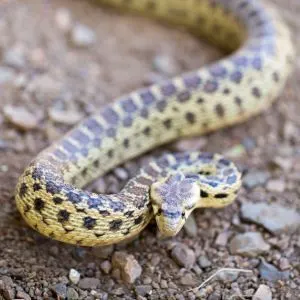
- Experience Level: Intermediate
- Family: Colubridae
- Scientific Name: Pituophis catenifer
- Other Names: Gopher Snake
- Adult Size: 4 to 7 feet; can reach up to 9 feet
- Lifespan: 12 to 15 years; up to 30 years in captivity
- Average Price Range: $30 to $100 per snake
The Gopher Snake is very heavy-bodied and is known as the longest snake in Wisconsin. They are pretty docile creatures except when threatened.
These guys will require a very secure enclosure as they are escape artists. They also require a lot of space due to their size and active nature.
Gopher snakes are usually a light tan to brown color with large, dark brown, sometimes reddish-brown spots and lined patterns throughout their length.
They can be found in Wisconsin’s pine or oak barrens, savannas, and sand prairies where they do a great job at keeping gopher populations from overabundance.
They really like to eat small rodents, which is actually how they got their name.
16. Bullsnake
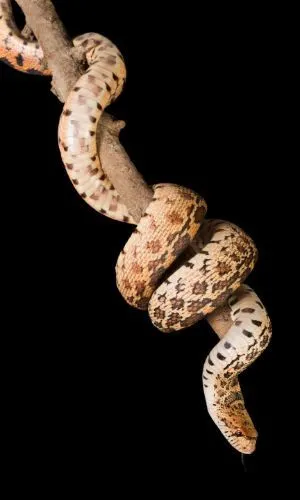
- Experience Level: Intermediate
- Family: Colubridae
- Scientific Name: Pituophis catenifer sayi
- Other Names: Bull Snake
- Adult Size: up to 8 feet
- Lifespan: up to 30 years in captivity; 12 years in the wild
- Average Price Range: around $200 per snake
Bullsnakes are a subspecies of the Gophersnake, meaning they are also the largest, longest snakes in Wisconsin. They can make good pets once accustomed to handling and captivity, which is why you want to look for captive-bred species.
The Bullsnake is a protected species in the state of Wisconsin, meaning you cannot keep them without a permit. You can apply for one at the Wisconsin Department of Natural Resources.
They are large constrictor snakes, though, meaning that they strangle their prey. This species will sometimes do this to more than one animal at a time. You also shouldn’t be too surprised if they try to bite.
Bullsnakes are often mistaken for rattlesnakes due to their similar behaviors. However, they are not as large, have round pupils, narrower heads, don’t have pits over their nostrils, and don’t have rattles on their tails.
These non-venomous snakes are hefty and large with a cream-colored or pale yellow body with brown, black, or copper blotching all throughout. Their heads and necks are almost the same in width as well.
They can be found in open country environments like old fields, native or bluff prairies, pastures, oak savannas, and steep hillsides. They roam sandy-soiled areas where rodents burrow and may also take shelter in agricultural fields, open forests, brush, and any sandy area.
These powerful constrictors live off gophers as well as other small mammals like mice and squirrels. They will also consume amphibians, birds, and their eggs.
17. Black Rat Snake
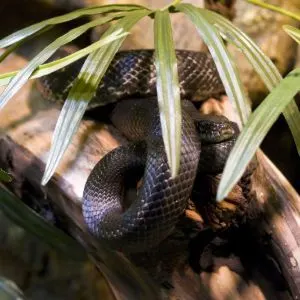
- Experience Level: Intermediate
- Family: Colubridae
- Scientific Name: Pantherophis obsoletus
- Other Names: Western Rat Snake, Black Ratsnake, Pilot Black Snake, Black Snake
- Adult Size: 3 to 6 feet
- Lifespan: 6 to 8 years
- Average Price Range: $50 to $100 per snake
Black Rat Snakes are a large snake. They are amongst one of the largest snakes, growing up to 6 feet long. They are also the most popular type of Rat Snake to keep in North America due to their docile nature, hefty size, and ability to help with rodent control.
As their name suggests, they are primarily black in color and may have faint white bands in between their scales. They usually have a white underside starting from their chins downward.
Hobbyists love these interesting creatures for their ability to help with pest control. They are called Rat Snakes, meaning they can be useful in helping you get rid of an overpopulation of rodents in your home, if needed.
This is why they are beneficial and sometimes kept by farmers.
They can be found in mountainous regions, rocky hillsides, or flat farmlands. They survive at various elevations and are actually proficient climbers, making homes in tree cavities that used to be the homes of other animals.
They consume rodents, amphibians, lizards, and also bird eggs.
18. Lined Snake
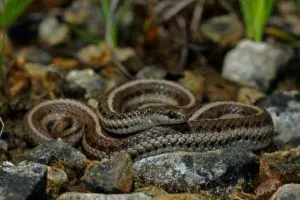
- Experience Level: Intermediate
- Family: Colubridae
- Scientific Name: Tropidoclonion lineatum
- Adult Size: 8 to 12 inches
- Lifespan: 3 to 10 years
We do not know much about Lined Snakes except that they are closely related to Garter Snakes, which help give us a little more information about these cute little critters.
These nocturnal snakes can often be found in urbanized areas, often discovered in parks, grassy areas, vacant lots, and under debris. They might also inhabit grasslands, abandoned prairies, woodland passages, oak forests, and suburban or residential areas.
They like to hide or find places to take shelter and will emit a musk if they are discovered or captured. They will rarely try to attack or bite someone.
They will often hide under leaf litter, rocks, or might burrow in the soil.
These tiny snakes basically look like mini Garter Snakes with brown or gray-brown bodies and dark stripes that can range from olive-gray to different ranges of grays.
Their undersides are cream-colored with two rows of gray blotches or spots. You may also find half-moons along their midline.
19. North American Blue Racer
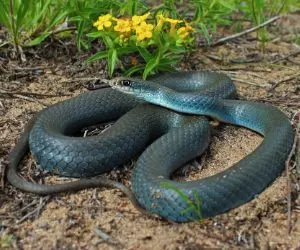
- Experience Level: Intermediate
- Family: Colubridae
- Scientific Name: Coluber constrictor
- Other Names: Black Racer, Racer, North American Racer
- Adult Size: Anywhere from 20 to 65 inches
- Lifespan: 10 years
- Average Price Range: $20 to $40 per snake (depending on size)
These slender snakes are versatile and are not a venomous species. They are called racers due to their incredible speed.
They are mostly docile creatures. However, if they feel threatened, they are ready to defend themselves. In most cases, it can be quite hard for these snakes to become accustomed to handling.
These snakes are silvery-grey and can sometimes be an almost metallic-looking electric blue. North American Racers will have a pale yellow or white underside and a black tongue.
A bite from them is shocking but harmless to humans or larger pets like dogs or cats.
They inhabit young or regrowing forest edges and shrubland. These Racers feed on small mammals, insects, smaller snakes, and lizards by swallowing them alive.
20. Western Wormsnake
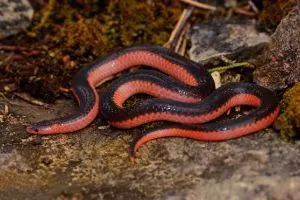
- Experience Level: Intermediate
- Family: Colubridae
- Scientific Name: Carphophis vermis
- Other Names: Worm Snake
- Adult Size: 7.5 to 11 inches
- Lifespan: 4 years in the wild
Since these tiny worm-like snakes can be found in the wild, they can be tempting to take home and try to keep as a pet. However, most of the time, they will die within a week or two in captivity due to their refusing to eat when they are in a changed habitat.
They will also just be hiding in the substrate the whole time since they do not like to be exposed. This will also make it hard for keepers to monitor their health.
You can find them under rocks or underground in exposed prairies, open woodlands, rocky hillsides, and any wooded areas.
They are two-toned with dark black or purple bodies and pink or red bellies.
21. Plains Gartersnake

- Experience Level: Beginner
- Family: Colubridae
- Scientific Name: Thamnophis radix
- Adult Size: 16 to 28 inches
- Lifespan: 5 years; sometimes up to 8 years
- Average Price Range: $20 to $300 per snake (depending on type and size)
These non-venomous snakes are friendly by nature, making them a great pet for beginners. They are also relatively small, meaning they aren’t fussy with tank size and are relatively easy to care for.
They are black with a distinctive, long yellow or orange stripe running along the whole length of their body. They eat anything they can get their jaws around including amphibians, worms, fish, eggs, and rodents.
They make great garden snakes since they will help you by eating and bugs or other pests.
They enjoy environments that are moist and grassy such as the areas found along streams, cattail ponds, wetlands, marsh, and lakes.
22. Prairie Ringneck Snake
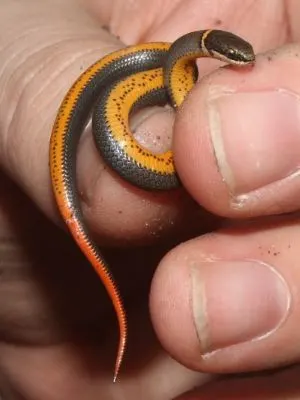
- Experience Level: Intermediate
- Family: Colubridae
- Scientific Name: Diadophis punctatus arnyi
- Other Names: Prairie Ring-necked Snake
- Adult Size: 10 to 15 inches
- Lifespan: 10 to 20 years in the wild; 6 or less in captivity
Ringneck Snakes are not the easiest to take care of since they have specific needs in order to stay alive. They also don’t make the best pets since they want to remain hidden at all times.
A lot of Ringnecks will be captured and taken from their habitats into the hands of overzealous first-time keepers. Usually, they will refuse to eat after a week or two in captivity.
If you are interested in trying to keep a Ringneck, please watch this video for more details:
Prairie Ringnecks have a gray or black head with a gray body and an orange ring that circles the top of their neck behind their head. Their undersides are a beautiful gradient of bright yellow, orange, and red with black specks.
As their name suggests, they prefer to live in or nearby prairies under old logs, woods, tin sheets, rocks, dead foliage, and grassy areas. In these habitats, they live off mollusks, amphibians, and worms.
23. Timber Rattlesnake
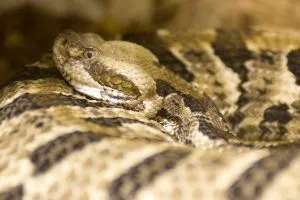
- Experience Level: Expert
- Family: Viperidae
- Scientific Name: Crotalus horridus
- Other Names: Canebrake Rattlesnake, Banded Rattlesnake
- Adult Size: 6 feet
- Lifespan: Anywhere from 10 to 30 years in the wild; 30+ years in captivity
In Wisconsin, the Timber Rattlesnake is a protected species. This makes it illegal to collect, keep, or kill it unless it is causing an immediate threat to humans or animals.
Rattlesnake bites are no joke and should be treated as a medical emergency. They are venomous, which can mean a bite from them will be very dangerous, and in some cases, even fatal if left untreated.
These vipers are usually gray or yellow-brown in color with dark brown blotches all or bands throughout their body and a brown, yellow, or copper stripe running down the length of their back.
They can generally be found in bluffs, croplands, rugged deciduous forest terrains, rocky ledges, and dense woodlands with closed canopies. They like to move around during different seasons and females will move to rocky terrains when they are pregnant for higher temperatures.
Timber Rattlesnakes feed mainly on smaller mammals but will also eat the occasional bird if they feel like it.
FAQs
Are bull snakes in Wisconsin?
Yes. Bull snakes are a subspecies of the Gopher snake and are also the longest snake found in Wisconsin. See list item 16 for more about Bull snakes.
Are fox snakes in Wisconsin
Yes, the Eastern Fox snake is found in Wisconsin. They can usually be found in herbal gardens, vegetated dunes, beaches, open woodlands or fields, and any open wetland environment
See list item 9 to learn more about the Eastern Fox snake.
Where do snakes go in winter in Wisconson?
During the winter snakes will go into any warm place they can find which will include dens made by other animals such as squirrels or other snakes. Other places include burrowing down in tree stumps, going into caves, or anywhere that will secuse them from weather. Once in their place they will brumate (different than hibernation).
What animals eat snakes in Wisconsin?
Predators of snakes can vary from larger birds like owls, hawks and other species, to honeybadgers, hedgehogs, and even other snakes like the Milk snake a subspecies of Kingsnake and item 5 on our list.
Where are rattlesnakes found in Wisconsin?
Rattlesnakes are found across the state, but they will be found bluffs, croplands, rocky ledges, in dense woodlands and more. See list item 23 for about the Timber rattlesnake.
Are there any venomous snakes in Wisconsin?
Yes, there are 3 species from this list that are venomous. The Timber rattlesnake is the most threatening and then you have the Eastern Hognose snake and the Northern ringneck snake that are slightly venomous.
Conclusion
Wisconsin is home to so many different species of snakes, giving us a wide variety to study and enjoy.
Whether you are a passionate snake-lover or are thinking about getting a pet snake, we hope that this article helped you better understand the laws in Wisconsin.
We also hope that you learned something new about what is roaming around the area.
Leave a comment below if you’ve ever had an interaction with one of these snakes in the wild!
You can also let us know about your experiences with any of the snakes on this list, whether it be keeping them or just an opinion. We’d love to hear it!
Snakes in other states
More Snake Stuff
To find out laws in Wisconsin check the Wisconsin DNR website.
